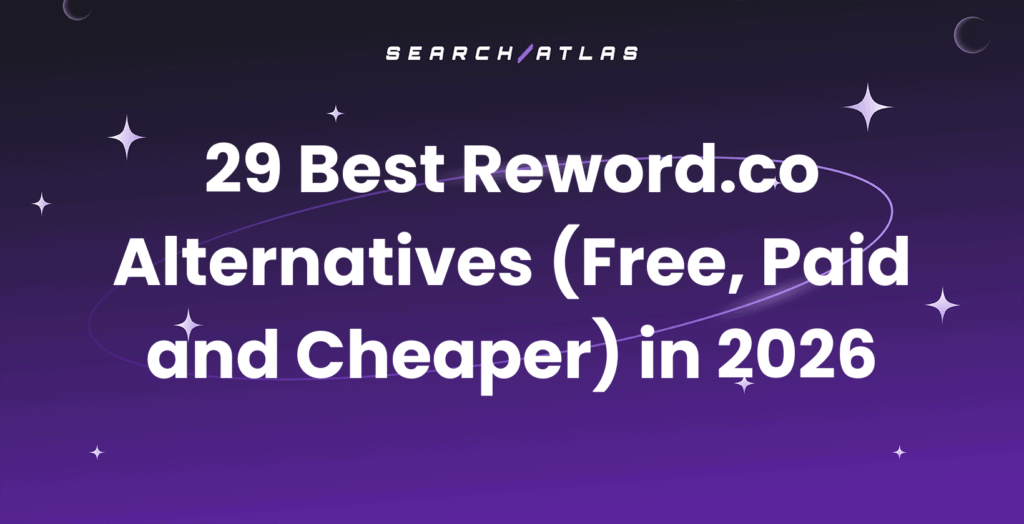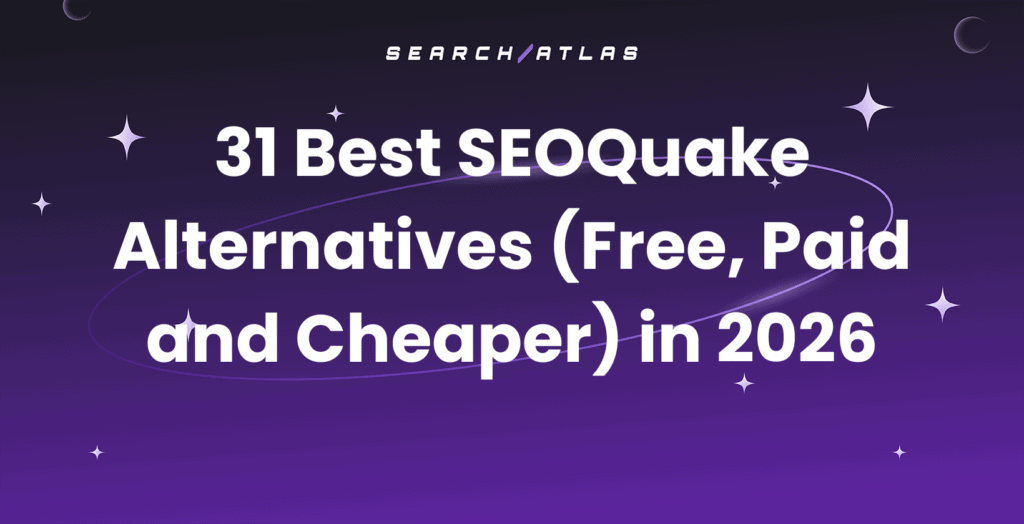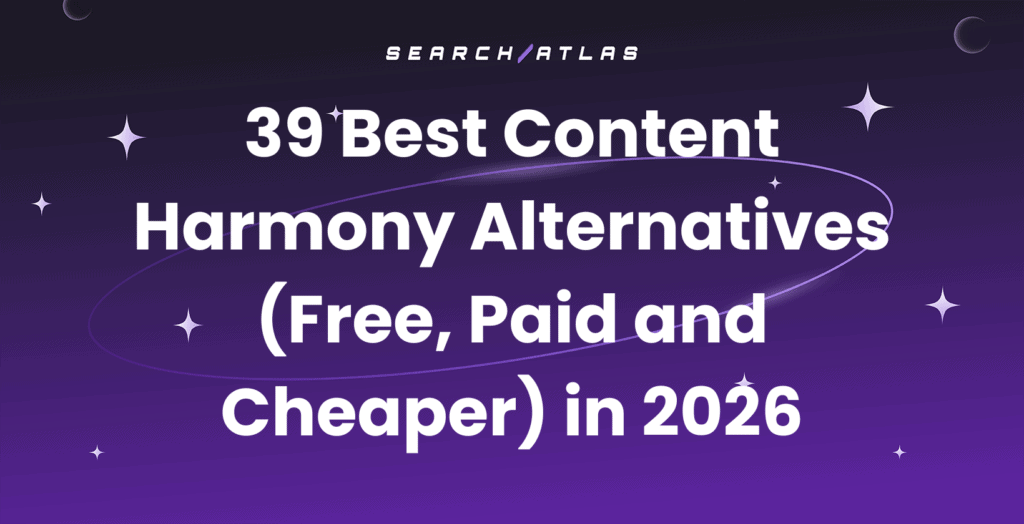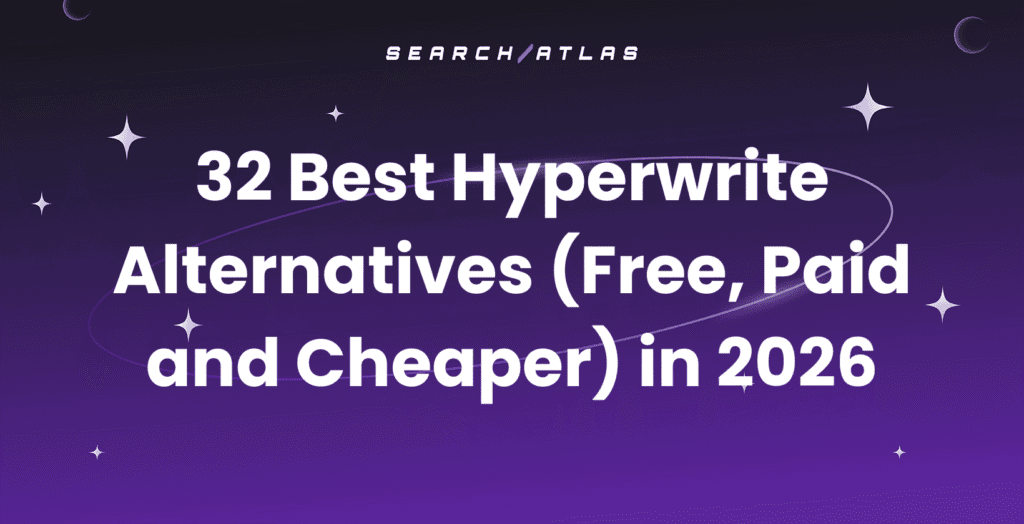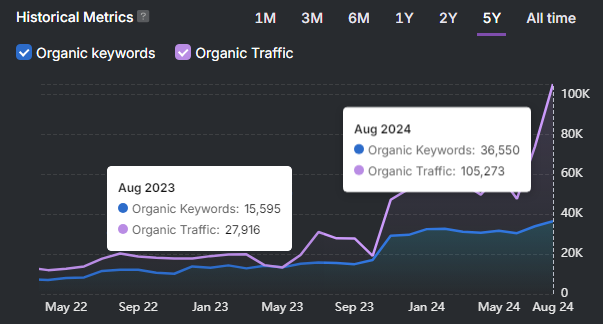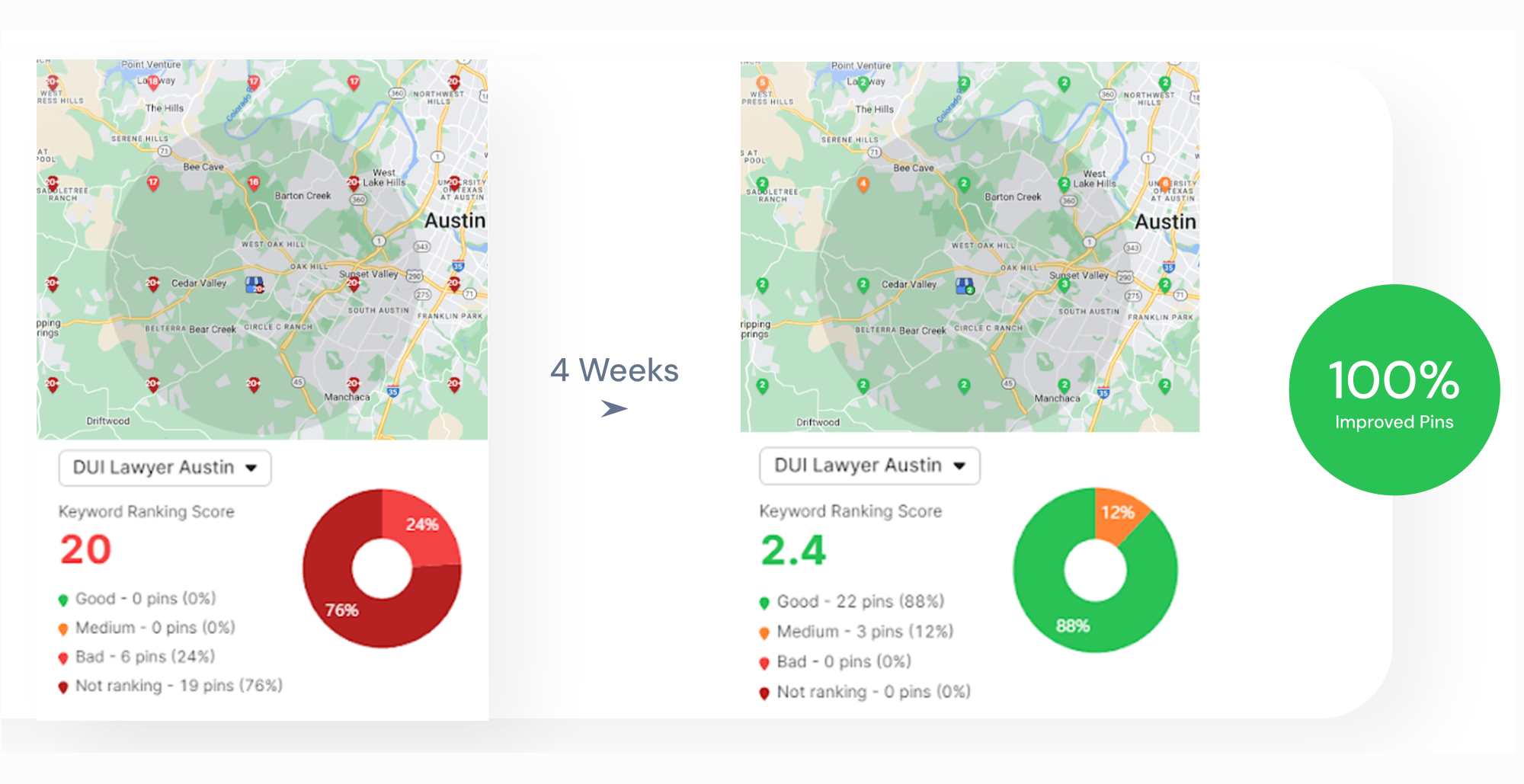Link building is the cornerstone of off-page SEO, involving the acquisition of hyperlinks (backlinks) from other websites to yours. Link building is one of the most challenging aspects of SEO and one of the most rewarding when done correctly. Quality backlinks serve as votes of confidence from one site to another, signaling to search engines that others vouch for your content.
Link building in SEO remains critically important. Google confirms that links are among their top ranking factors, alongside high-quality content and page experience. A strong backlink profile helps establish your site’s authority, improves organic rankings, and drives valuable referral traffic. Our link building guide focuses on sustainable techniques that build genuine authority instead of shortcuts that risk Google penalties.
The most effective link building strategies now focus on quality over quantity. Guest blogging, broken link building, resource page link building, digital PR campaigns, and the skyscraper technique all work to attract high-quality backlinks. While building links takes considerable effort, the payoff in terms of improved search visibility and domain authority makes it well worth the investment for website owners.
What is Link Building?
Link building is the deliberate process of acquiring hyperlinks from other websites to your own website to improve search engine rankings. Linkbuilding creates connections between web pages that help users navigate the internet while simultaneously building credibility for your domain in the eyes of search engines.
At its core, link building works because search engines use links to discover new web pages and determine how they should rank in search results. When Google’s crawlers find a link pointing to your site, they follow that path to index your content. More importantly, they interpret each link as an endorsement, essentially counting it as a vote that your page deserves attention.
What is the Anatomy of a Link (Hyperlink)?
A link or hyperlink has two main parts: the clickable element (like text, an image, or a button) and the underlying code that makes it work. This code is an HTML, specifically the <a> tag, and it uses the href attribute to tell the browser which web page to open when the element is clicked, by specifying the URL.
<a href="https://example.com/page" title="Description of the link" rel="nofollow">Anchor Text</a>
The main components of a hyperlink are listed below.
- Anchor Tag. The
<a>element that defines the hyperlink - Href Attribute. The attribute that specifies the destination URL where the link points to.
- Anchor Text. The clickable text visible to users that describes the link’s destination.
- Title Attribute. The optional text that appears when a user hovers over the link.
- Rel Attribute. The attribute that defines the relationship between the current page and the linked page (like “nofollow,” which tells search engines not to pass PageRank).
Search engines analyze the anchor text to understand the relevance, while the href attribute determines where link equity flows. The rel attribute can control whether a link passes SEO value.
How Are Links Used in Search Engines?
Search engines use links to discover new content, understand relationships between pages, determine authority and relevance, evaluate context, and assess link quality. Modern search engines like Google identify manipulative link building tactics and penalize websites engaged in schemes designed to inflate link counts artificially.
When Google Search was first created, its founders, Larry Page and Sergey Brin, revolutionized search with their PageRank algorithm. Unlike earlier search engines that mostly looked at on-page factors, PageRank evaluated a webpage’s importance based on how many other pages linked to it and how important those linking pages were themselves. It is like a voting system where links are votes, but votes from authoritative websites count more than others.
Today’s search algorithms have evolved far beyond the original PageRank concept, but links remain fundamental to how search engines work. When Google’s crawlers find a link to your page, they follow it like a path to discover your content. More importantly, these links help the search engine understand what your page is about (through anchor text), how trustworthy it is (based on the linking site’s authority and reputation), and how relevant it might be for specific queries.
A well-placed link from a relevant article about dog training to your page about puppy socialization tells Google much more than just that your page exists. It suggests your content is valuable enough for an established site to reference, and it helps establish the topical relevance of your content.
What is the Importance of Link Building in SEO?
Link building directly influences how search engines measure your website’s credibility in your industry’s ecosystem. When industry leaders (authoritative sources) link to your website, they pass link equity (also known as “link juice”), establishing your place in the competitive hierarchy. Link building in SEO remains fundamentally important because search engines like Google continue to use links as a primary ranking factor, alongside content quality and user experience signals.
From a technical perspective, quality backlinks improve your SEO performance by increasing your website’s crawl frequency, helping search engines understand your content’s topical relevance, and providing algorithm update protection through a diverse, natural link profile. These benefits exceed ranking improvements to strengthen your entire digital presence.
The benefits of link building are listed below.
- Improved search engine rankings. Link building strengthens your position in search results through trust signals from authoritative websites.
- Increased domain authority. Link building transfers credibility from established websites to yours, building overall site trustworthiness
- Enhanced visibility and traffic. Link building creates multiple discovery pathways for potential customers during their research phase.
- Faster content indexing. Link building increases crawling frequency, helping new content appear quickly in search results
- Brand building benefits. Link building creates valuable industry associations that position you alongside established authorities
Unlike paid advertising, which stops delivering results when campaigns end, quality backlinks provide ongoing value in SEO that compounds over time, making strategic link building one of the most cost-effective investments for sustainable search visibility.
What are the Best Link Building Strategies for SEO?
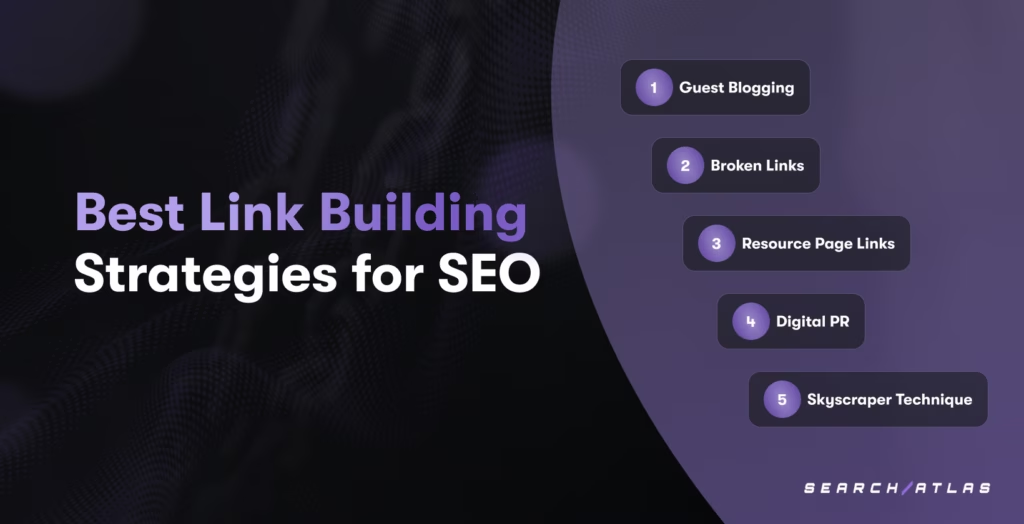
The best link building strategies for SEO combine creativity, persistence, and adherence to search engine guidelines. You need a link building strategy focused on acquiring high-quality, relevant links that improve your site’s authority and search visibility.
The best link building best practices currently used by SEO professionals are listed below.
1. Guest Blogging
Guest blogging is the practice of writing and publishing content on someone else’s website or blog to build relationships, exposure, authority, and links. Guest blogging strategy works best when you focus on creating genuinely valuable content for the host site’s audience.
Guest blogging builds relationships with other content creators in your industry and exposes your content to new audiences. It establishes your expertise and authority and creates opportunities for contextual, relevant backlinks. These relevant links result in qualified referral traffic to your website.
To do guest blogging, you need to find websites that match your niche and appeal to your target audience, propose a guest post concept to them, and, if approved, create and publish the article on their site. The best practices for guest blogging are listed below.
- Focus on high-quality, relevant sites in your niche.
- Pitch unique, valuable content ideas tailored to the host site’s audience.
- Follow the site’s guest posting guidelines carefully.
- Create all-around, well-researched content that showcases your expertise.
- Include natural, contextual links where they add value (not just for SEO).
- Promote your guest posts to extend their reach and impact.
The Search Atlas Content Genius Tool can help identify potential guest blogging opportunities by analyzing websites that rank for your target keywords. The Search Atlas Content Genius Tool also assists in developing content ideas that align with the host site’s existing content strategy.
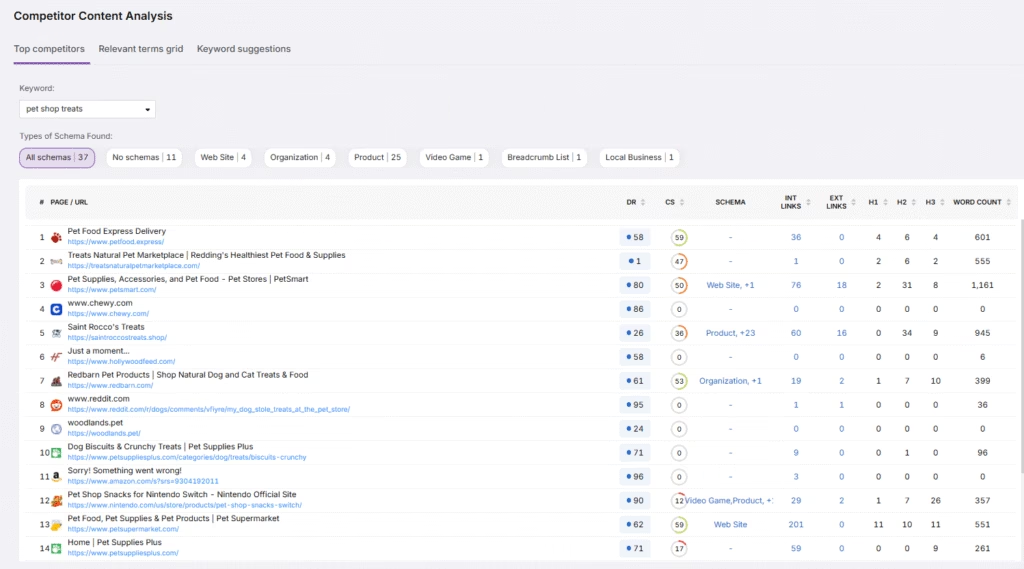
2. Broken Link Building
Broken link building involves finding dead links on relevant websites and suggesting your content as a replacement. The broken link building strategy provides value to the site owner by helping them fix broken links while securing a backlink for your site.
The procedure for broken link building is listed below.
- Identify websites in your niche that might link to your content.
- Find broken links on these sites using tools like the Search Atlas Site Audit Tool.
- Create content that serves as a suitable replacement for the broken link.
- Reach out to the website owner to suggest your content as an alternative.
Broken link building is effective because it offers a win-win solution. The website owner improves their user experience by fixing broken links, and you gain a relevant backlink. The key to success in broken link building is ensuring your suggested replacement content is highly relevant and provides substantial value.
The Search Atlas Site Audit Tool makes finding broken links straightforward and efficient. When you finish an audit of your chosen website within The Search Atlas Site Audit Tool, navigate to the Issues section and look for the “External Broken Links” category, which shows all pages containing broken outbound links.
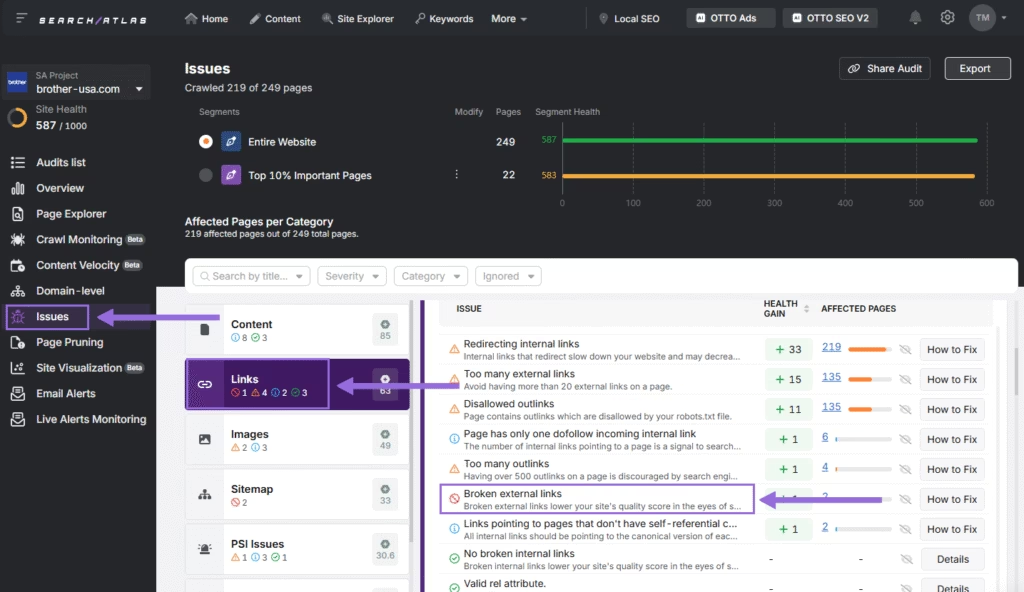
Review the affected pages and their health scores to prioritize your outreach targets. Click on specific pages to see exactly which external links are broken and where they’re located.
After you have found your broken link opportunities, you can streamline your outreach process with pre-built templates within the Email Templates feature of the Search Atlas Digital PR Tool.
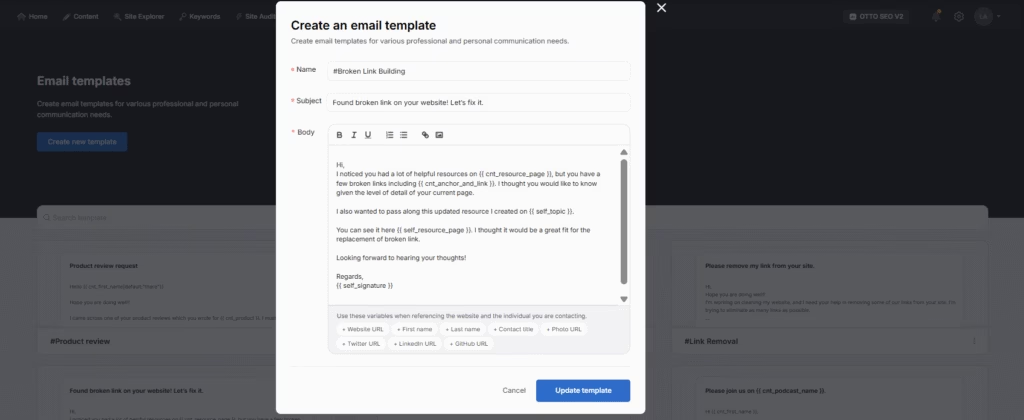
You can customize the template with specific details about the broken links you found and use the built-in variables to personalize your message with the website name, contact name, and other details.
For best results, focus on websites with strong domain authority but manageable broken link issues (5-10 broken links rather than hundreds). This indicates the site is actively maintained but may have overlooked these specific link problems.
3. Resource Page Link Building
Resource page link building is the process of getting your website featured on curated resource pages that list valuable content within a specific niche or industry. Resource pages are web pages specifically created to compile and share helpful resources, tools, guides, and reference materials on particular topics. These pages exist to provide value to their audience by gathering the best resources in one convenient location.
The benefits of resource page link building include gaining highly relevant backlinks from pages designed specifically to send visitors to quality resources, establishing your site as an authority within your industry, and securing links that typically have higher click-through rates since visitors actively browse these pages looking for useful resources. Additionally, resource page links tend to be more permanent than other backlink types, providing long-term SEO value.
Resource page link building involves the steps listed below.
- Finding relevant resource pages using search operators like “industry + useful resources” or “topic + helpful links”.
- Creating high-quality content that would be valuable for the resource page’s audience.
- Reaching out to the page owner with a personalized pitch explaining why your content deserves inclusion.
The Email Templates feature of the Search Atlas Digital PR Tool provides pre-built email templates specifically designed for resource page link building outreach.
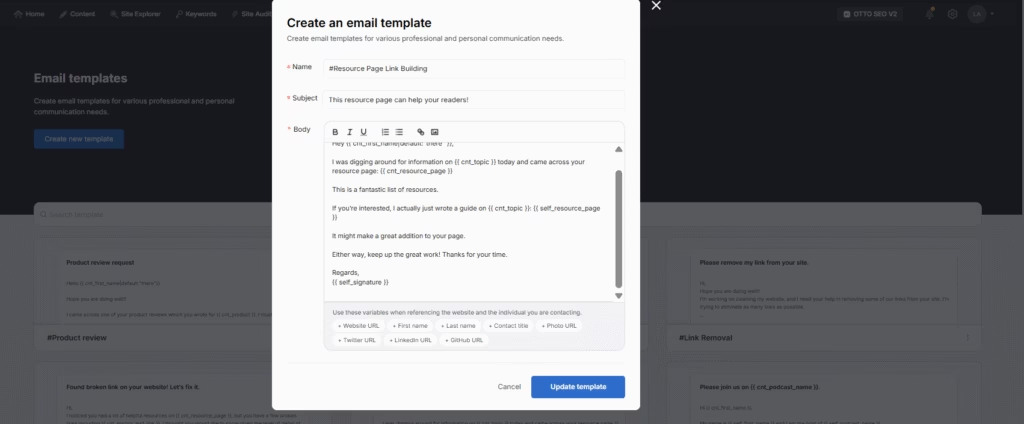
These email templates save time while ensuring your outreach is professional and effective, increasing your chances of securing valuable resource page backlinks.
4. Digital PR
Digital PR combines traditional public relations tactics with digital marketing strategies to earn mentions and links from online publications. Digital PR focuses on creating newsworthy content and building relationships with journalists and content creators.
Digital PR involves the elements listed below.
- Creating newsworthy content, studies, or data.
- Developing relationships with journalists and online publishers.
- Crafting compelling pitches tailored to each publication’s audience.
- Securing coverage that includes links back to your website.
The Press Release Distribution feature within the Search Atlas Digital PR Tool perfects your digital PR pitches by providing the best press release distribution services across relevant media outlets, increasing your chances of earning high-quality media coverage and links.
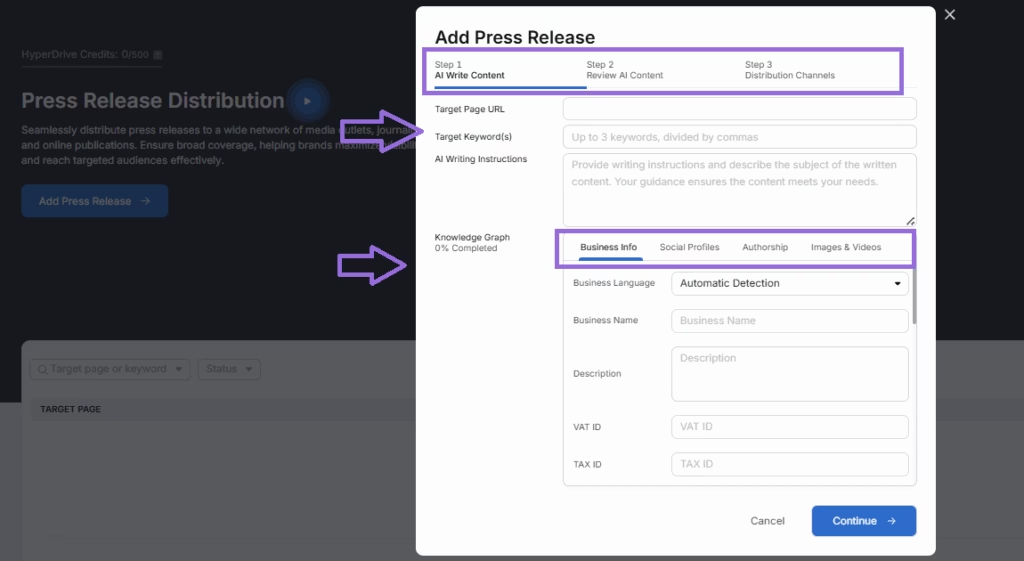
5. Skyscraper Link Building Technique
The Skyscraper link building technique involves creating content that improves upon existing top-performing content in your industry, then reaching out to sites that link to the original content to suggest your enhanced version.
The Skyscraper link building technique consists of three main steps as listed below.
- Find popular, link-worthy content in your niche.
- Create something significantly better (more comprehensive, up-to-date, better designed, etc.).
- Reach out to websites that link to the original content to suggest your improved version.
For example, a fitness website owner discovers that an article titled “25 Bodyweight Exercises for Home Workouts” has attracted over 200 backlinks from fitness blogs, health publications, and personal trainer websites. Using the Search Atlas Backlink Research Tool, they identify this content as a link magnet in their niche.
The website owner then creates an improved version titled “50 Bodyweight Exercises for Home Workouts: The Complete Visual Guide.” They identify the websites linking to the original article and craft personalized outreach emails using the Search Atlas Digital PR Tool.
As a result, 45 out of 200 sites they contacted updated their links to point to the new, superior resource, substantially boosting referral traffic and search rankings.
The Skyscraper technique works because you’re offering genuine value, that is, content that’s demonstrably better than what these sites are currently linking to. But to succeed, you need to ensure that your content truly surpasses the original in quality, depth, and usefulness.
What Advanced Link Building Tips to Consider?
Advanced link building tips build up your link profile and give you an edge over competitors. These advanced link building techniques typically require more expertise and resources but deliver powerful results.
The most effective advanced link building tips are listed below.
1. Create Linkable Assets
Creating linkable assets focuses on developing highly valuable resources specifically designed to attract links, such as tools, calculators, guides, or unique visual content like infographics. Instead of creating general content and hoping for links, you build resources with link acquisition as a primary goal.

The benefits of linkable assets include higher link acquisition rates compared to standard content, longer link generation lifespans as quality tools and resources remain valuable for years, and natural anchor text distribution as people link in contextually appropriate ways.
The best practices for creating linkable assets are below.
- Identify specific audience needs that aren’t being fully met.
- Investing in quality design and user experience.
- Make sharing and linking easy with embed codes or citation instructions.
- Promote your asset actively to relevant communities after launch.
2. Leverage Data-Driven Content
Data-driven content creation involves producing original research, statistics, surveys, or data analysis that generates natural backlinks from sites seeking to reference your findings. Data-driven content creation works because unique data is inherently linkable. Journalists, bloggers, and industry experts constantly search for original statistics and research to support their content.
The benefits of data-driven content include establishing your brand as an authority in your industry, creating a sustainable source of passive link acquisition, and generating significantly higher-quality backlinks than those acquired through outreach alone. These links tend to use natural anchor text, creating a more organic backlink profile.
The best practices for data-driven content creation are listed below.
- Focus on topics with existing interest but limited research.
- Ensure methodological data collection.
- Present findings visually through charts and infographics.
- Make data easily shareable and citable.
- Include a clear methodology section to build credibility.
3. Use Relationship-Based Link Building
Relationship-based link building involves cultivating genuine connections with influencers, journalists, and content creators before making link requests. Relationship-based link building prioritizes long-term relationship development over immediate link acquisition, resulting in higher-quality backlinks and ongoing opportunities.
Relationship-based link building yields higher response and success rates compared to cold outreach, access to more authoritative linking opportunities, and the potential for multiple links over time instead of one-off placements.
Best practices for relationship-based link building include first engaging authentically with industry contacts on social media, second providing value before asking for links, third personalizing all communications, and lastly, maintaining relationships even after securing links.
The Search Atlas Digital PR Tool supports relationship building with its contact management system, allowing you to track interactions, set follow-up reminders, and note individual preferences for each contact. The Search Atlas Digital PR Tool ensures consistent, personalized communication that builds stronger industry relationships.
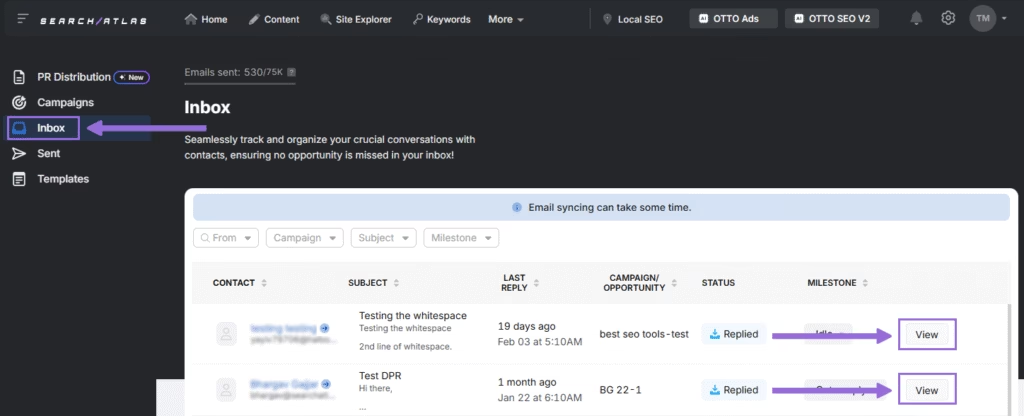
4. Employ Strategic Content Promotion
Strategic content promotion refers to distributing your content through multiple channels to increase visibility and link potential. Strategic content promotion ensures your linkable assets reach the right audiences who have the ability and inclination to link back to your content.
The benefits of strategic content promotion include maximizing the ROI of your content creation efforts, reaching potential linkers who might not discover your content organically, and generating initial social proof that encourages further sharing and linking.
Best practices for strategic content promotion include first identifying platform-specific promotion strategies, then segmenting outreach lists by relationship strength and authority level, timing promotion efforts strategically instead of all at once, and, finally, tracking which promotion channels deliver the best results for different content types.
Strategic content promotion creates multiple opportunities for engagement, sharing, and potential backlinks from followers who might reference these resources on their own websites.
5. Monitor Competitors’ Backlinks
Monitoring competitors’ backlinks involves regularly analyzing your competitors’ new backlinks to identify opportunities you might have missed. Competitive backlink monitoring treats competitors as unwitting research partners who reveal valuable link sources in your shared niche.
Monitoring competitors’ backlinks delivers the benefits of discovering new link opportunities with proven relevance to your industry, identifying which content types attract links in your space, and understanding relationship networks within your niche.
The best practices for competitive backlink monitoring are listed below.
- Setting up regular monitoring schedules.
- Focusing on new links, not historical profiles.
- Analyzing patterns in link acquisition (not just individual links).
- Prioritizing opportunities based on relevance and authority.
The Search Atlas Link Gap Analysis Tool automates this process by comparing your backlink profile against multiple competitors simultaneously. The Search Atlas Link Gap Analysis Tool highlights domains linking to competitors but not to you, sorting opportunities by authority and relevance to prioritize your outreach efforts.

6. Implement Tiered Link Building
Tiered link building refers to strategically creating a multi-level link structure where high-quality links point to your linkable assets, which in turn link to your commercial pages. The tiered link building maximizes the flow of link equity to your most important content.
Tiered link building boosts the impact of your most valuable backlinks, creates a more natural link ecosystem around your content, and maximizes return on your link building investment by focusing resources on strategic priorities.
Best practices for tiered link building include keeping your tier structure limited to two levels (Tier 1, Tier 2) for most campaigns, ensuring all content provides genuine value regardless of tier, varying your link building tactics between tiers, and maintaining strict quality control even for secondary tier links.
What Makes a High-quality Link?
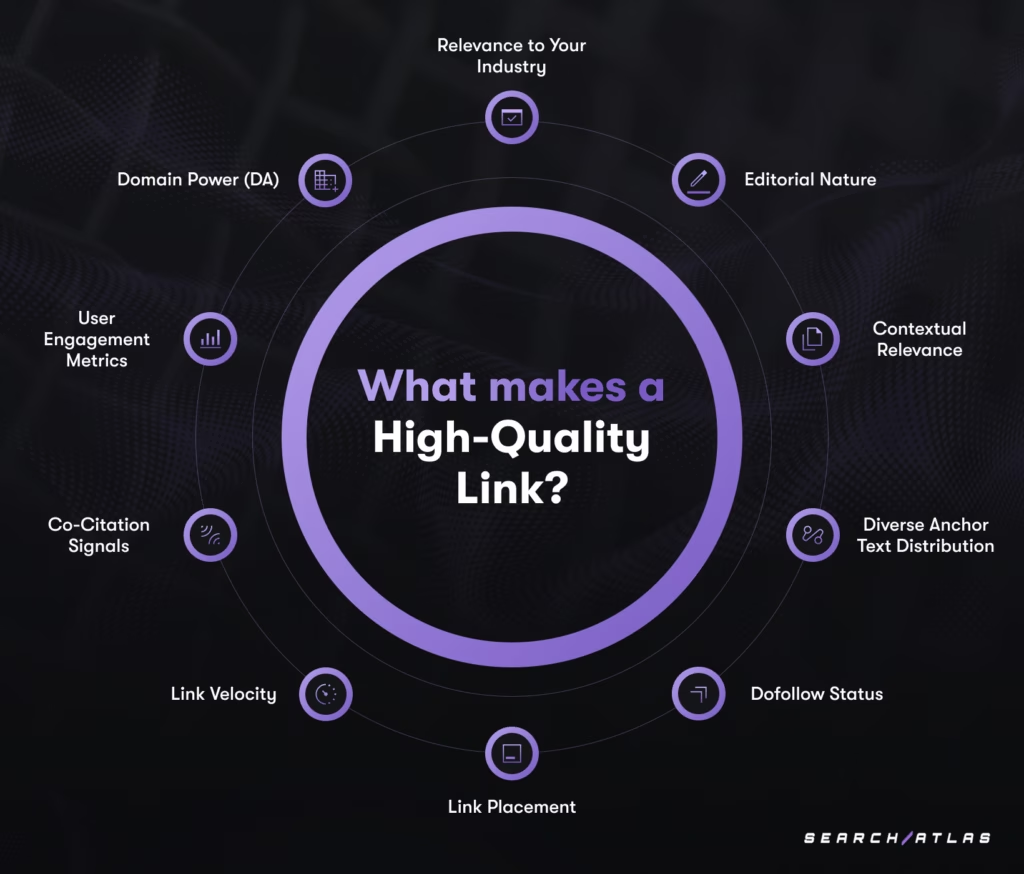
A high-quality link is an inbound hyperlink from another website that greatly enriches your site’s authority, relevance, and search visibility. High-quality link building is focused on creating valuable content, forming genuine relationships with industry websites, and employing ethical outreach methods.
The characteristics of a high-quality link are listed below.
- Authority of the Linking Domain. Links from websites with high Domain Power (DA) carry more weight. Domain Power, a next-generation metric developed by the Search Atlas SEO Software Platform, is emerging as the more accurate and reliable authority signal when compared to Domain Authority (DA) and Domain Rating (DR).
- Relevance to Your Industry. Links from websites within your niche or related industries provide contextual value. Search engines interpret these as more meaningful than random links from unrelated sources.
- Editorial Nature. Natural links earned through quality content, not through paid placements or manipulative tactics demonstrate genuine value to users.
- Contextual Relevance. Links embedded within relevant context, surrounded by related content, carry more weight than isolated links in irrelevant sections.
- Diverse Anchor Text Distribution. A natural mix of branded anchors, naked URLs, partial match anchors, and generic anchors creates a healthy link profile.
- Do-Follow Status. “Follow” links pass link equity (ranking power), while “nofollow” links provide less direct SEO value but still contribute to a natural link profile.
- Link Placement. Links positioned within the main content area typically carry more value than those in navigation menus, footers, or sidebars.
- Link Velocity. A natural, steady acquisition rate of backlinks appears more authentic than sudden spikes that may trigger algorithmic penalties.
- Co-Citation Signals. Links appearing alongside other quality outbound links to authoritative sources amplify contextual relevance.
- User Engagement Metrics. Links that drive actual referral traffic and engagement demonstrate real-world value exceeding SEO benefits.
Understanding the value of potential backlink opportunities requires reliable metrics that accurately reflect Google’s evaluation criteria. Domain Power stands out as the most precise authority metric available today.
Domain Power analyzes actual performance data rather than counting links. By incorporating organic traffic patterns, ranking keywords, and other engagement signals that Google prioritizes, Domain Power reveals which websites truly command authority in search results.
Unlike traditional metrics that can be artificially inflated through link manipulation tactics, Domain Power cannot be gamed. This guarantees you’re pursuing genuine authority sources and not wasting resources on domains with inflated metrics but minimal ranking power.
What Are the Best Link Building Tools?
The best link building tools provide features for discovering, analyzing, and acquiring high-quality backlinks that improve search visibility and domain authority. Link building tools help identify opportunities, assess link quality, and streamline outreach efforts for more efficient link acquisition.
The best link building tools include free Google tools and holistic paid solutions like Search Atlas SEO platform that provide specialized link building features. These tools offer different capabilities for analyzing backlink profiles, identifying link opportunities, and managing outreach campaigns. The best link building tools are listed below.
Google Search Console (GSC) provides detailed reports on websites linking to your pages, showing the number of linking pages and top-linked content. The Links report helps identify which content attracts the most backlinks, guiding your content strategy for link acquisition.
Google Alerts enables monitoring of brand mentions and link opportunities by sending notifications when specified keywords appear online. Setting up alerts for your brand name helps identify unlinked mentions that can be converted to backlinks through outreach.
Google Search Operators help find targeted link building opportunities using advanced search queries. Operators like “intitle:”, “inurl:”, and “site:” combined with industry-specific keywords uncover resource pages, guest posting opportunities, and broken links.
Search Atlas SEO Software Platform offers extended link building capabilities. Search Atlas link analysis tools, such as the Search Atlas Backlink Research Tool, deliver detailed metrics on backlink quality and growth trends. The Search Atlas Link Gap Analysis Tool uncovers opportunities by comparing your domain against competitors to find websites linking to them but not to you.
For outreach management, Search Atlas outreach tools streamline the process of finding and contacting publishers and bloggers. The Site Explorer Tool reveals the backlink strategies of top-ranking sites in your niche, helping identify successful tactics you can adopt.
Search Atlas OTTO SEO Tool automates aspects of your link building strategy, allowing you to streamline your outreach efforts with a single click. A standout feature of the Search Atlas OTTO SEO Tool is WILDFIRE (Websites Inter-Linking Directly Fostering Influence, Reputation, and Engagement), which is a smart, closed-network link exchange system designed to build links with domain power and topical dominance.
Search Atlas OTTO SEO Tool’s WILDFIRE feature is an AI-driven link exchange network designed to help you acquire high-authority backlinks sustainably and strategically. WILDFIRE operates on a 2:1 model. Adding two outbound links to relevant, high-quality sites earns one inbound link from a topically relevant domain. Unlike traditional link exchanges, WILDFIRE enforces rigorous quality standards with regular authority checks and domain compatibility scoring to preserve network integrity.
Combining Google’s tools with the AI-powered Search Atlas SEO platform tools creates a complete system for identifying link opportunities, analyzing link quality, conducting effective outreach, and monitoring results.
How to Build Links With Content Marketing
Building links with content marketing forms a powerful synergy when executed correctly. High-quality content serves as the foundation for earning natural, editorial links.
The link building process through content marketing involves 5 key steps. The steps for link building with content marketing are listed below.
- Create link-worthy content. Develop content with unique value, such as original research, thorough guides, or innovative insights that others want to reference.
- Identify content gaps. Use the Search Atlas Content Genius Tool to find topics with high link potential that haven’t been covered by competitors.
- Diversify content formats. Experiment with different formats like videos, infographics, or interactive tools that tend to attract more links than standard text.
- Promote content strategically. Share your content with influencers, relevant communities, and industry publications where it might earn links.
- Update content regularly. Refresh older content with new information to maintain its linkworthiness over time.
The most successful content for link building typically offers one or more of the qualities of comprehensive information, unique data, actionable advice, emotional impact, or innovative presentation. Focusing on creating truly valuable content creates natural opportunities for link acquisition.
How to Build Links With Email Outreach
Building links with email outreach remains one of the most effective tactics for acquiring quality backlinks. Successful link building outreach follows the best practices listed below.
- Personalize your outreach. Research each prospect thoroughly and customize your message to show you understand their website and audience.
- Provide clear value. Explicitly state how your content benefits their audience or solves a problem on their site.
- Keep emails concise. Respect recipients’ time with brief, scannable messages that get to the point quickly.
- Follow up thoughtfully. Send a maximum of 2-3 follow-ups, spaced several days apart, without being pushy.
- Track and optimize. Monitor response rates and continuously refine based on what works.
Example outreach templates are effective starting points, but you should always customize them for each recipient. The most successful email outreach demonstrates genuine interest in the recipient’s work and offers something of real value in exchange for link consideration.
What Businesses Need Link Building the Most?
The businesses that need link building the most are those operating in competitive markets where search visibility directly impacts lead generation and revenue. These businesses typically have longer customer journeys that involve substantial online research before purchasing decisions are made.
The 8 types of businesses that need link building the most are listed below.
- Local Businesses. Local service providers such as restaurants, dentists, law firms, and contractors rely heavily on local search visibility to attract nearby customers. For local businesses, quality backlinks from local news outlets, community websites, and regional directories seriously improve the chances of appearing in local packs and map listings.
- SaaS Businesses. SaaS (Software-as-a-Service) companies operate in intensely competitive markets where content marketing and organic visibility are primary customer acquisition channels. SaaS businesses need high-quality backlinks to establish authority in their niche, rank for high-intent keywords, and support their typically extensive content marketing efforts.
- Financial Advisors and Institutions. Financial advisors and institutions need to establish exceptional trust and credibility online. Backlinks from authoritative finance websites, news publications, and educational resources help build this trust while improving rankings for highly competitive financial search terms.
- Insurance Companies. The insurance industry faces some of the highest customer acquisition costs online, with extremely competitive keywords. Insurance companies benefit from link building to reduce paid search costs and establish authority in specific insurance categories.
- Travel Websites. Travel companies, booking platforms, and destination guides compete for high-volume, seasonal search terms. Strong backlink profiles help travel websites maintain visibility during peak booking seasons and rank for destination-specific search queries.
- E-commerce Stores. E-commerce stores or online retailers with many product pages need link authority to compete with marketplace giants like Amazon. Category and product page links help improve visibility for high-conversion product searches.
- Educational Institutions. Educational institutions such as colleges, universities, and online learning platforms rely on organic search for student recruitment. Authority-building links improve rankings for program-specific searches and educational resource queries.
- Healthcare Providers. Medical practices, hospitals, and healthcare services must establish exceptional credibility. Backlinks from medical authorities and health publications especially impact visibility for symptom and treatment searches.
According to link building statistics from uSERP, 38.43% of businesses allocate between $1,000 and $5,000 per month to link building. Another 34.14% invest up to $1,000 monthly, while 20.29% spend between $5,000 and $10,000. Up to 7% of businesses exceed $15,000 per month on backlinks.
How to Start a Link Building Agency?
Starting a link building agency requires specialized knowledge of search engine optimization, strong relationship-building skills, and effective operational processes. A link building agency helps businesses improve their search visibility by acquiring high-quality backlinks from relevant websites through strategic outreach and content creation.
There are 10 essential steps to start a successful link building agency that delivers measurable results for clients while maintaining sustainable growth. The steps are listed below.
- Develop specialized link building expertise. Master the fundamentals of SEO and focus specifically on backlink acquisition strategies, including guest posting, broken link building, and digital PR. Stay updated with Google’s algorithm changes and how they affect link building best practices through industry publications and research.
- Define your link building services. Create a clear service offering that outlines your direction for acquiring links, including the types of links you’ll pursue, your quality standards, and your reporting processes.
- Develop service packages: Structure clear link building service offerings to match different client needs and budgets. Consider leveraging white-label SEO services like Search Atlas White-Label SEO to offer fully branded, customizable reports and services under your agency’s name.
- Build your website and brand. Create a professional website showcasing your link building expertise, case studies, and service offerings. Implement the same link building strategies for your site that you’ll offer to clients to demonstrate your capabilities and establish authority in the SEO space.
- Invest in essential SEO tools: Leverage professional tools such as the Search Atlas SEO platform for link building management, including analysis, prospecting, and monitoring.
- Define your target market: Choose to specialize in specific industries or types of link building to differentiate your agency as a link building specialist.
- Establish effective outreach methodology. Create personalized templates and follow-up sequences that focus on providing value. Train team members on relationship-building techniques that improve success rates.
- Optimize for enterprise-level clients: Develop systems for handling large-scale link building campaigns. Use Search Atlas Enterprise SEO to manage campaigns for clients with multiple locations or complex link building needs.
- Create transparent reporting. Develop processes that communicate the value of acquired links, including metrics like domain power and relevance. Set realistic client expectations for timeframes and results.
- Scale smart. Expand your team and service offerings gradually based on performance data and client feedback.
Is Link Building Still Good for SEO?
Yes, link building remains essential for SEO in 2025. Despite numerous algorithm updates and the evolution of search ranking factors, backlinks are still one of the most important indicators of content quality and authority that search engines use.
What has changed is not as much the importance of links but the quality standards search engines apply when evaluating them. Websites should focus on earning natural links from reputable sources instead of relying on quantity or potentially spammy tactics.
What is White Hat Link Building?
White hat link building refers to ethical, sustainable link acquisition practices that comply with search engine guidelines and focus on creating value for users. White hat-building techniques aim to earn links based on the merit of your content and website instead of through manipulation or deception.
White hat link building is characterized by the elements listed below.
- Creating genuinely valuable, link-worthy content.
- Building real relationships with website owners and content creators.
- Focusing on relevant links from authoritative sources.
- Prioritizing user experience and value above search rankings.
- Taking a long-term approach to link acquisition.
Examples of white hat link building tactics include guest posting on relevant websites with valuable content, creating shareable resources that naturally attract links, broken link building that helps site owners fix issues, and earning links through legitimate PR efforts.
The advantages of white hat link building include sustainable results, reduced risk of penalties, and the creation of actual value for your audience. White hat techniques may require more time and effort than shortcuts, but they build a real, solid foundation for long-term SEO success.
Will Black Hat Link Building Destroy Your SEO?
Yes, black hat link building severely damages your SEO and can potentially destroy your website’s visibility in search results. Black hat link building refers to manipulative tactics that violate search engine guidelines, such as buying links, participating in link farms, using automated link building software, or creating private blog networks (PBNs) specifically to manipulate rankings.
The risks of engaging in black hat link building are below.
- Google penalties. Manual actions that can remove your site from search results entirely.
- Algorithmic devaluation. Filters like Penguin can automatically identify and discount manipulative links.
- Brand reputation damage. Association with spammy practices can harm your company’s image.
- Wasted resources. Time and money are spent on tactics that ultimately hurt your site.
- Loss of organic traffic. Penalties can result in dramatic traffic drops that are difficult to recover from.
Search engines have become increasingly sophisticated at detecting unnatural link patterns. What might have worked years ago is now easily identified as manipulation. Recovery from serious link penalties can take months or even years, requiring extensive link removal and disavowal efforts.
Even if black hat techniques provide short-term ranking boosts, they carry substantial long-term risks that far outweigh any temporary benefits
What is the Difference Between Link Building and Backlinks?
While the terms “link building” and “backlinks” are often used interchangeably, they represent different but related concepts in SEO.
Link building is the strategic process and set of activities undertaken to acquire backlinks. Link building encompasses the various techniques, outreach efforts, and content strategies designed to encourage other websites to link to yours. Link building is the active practice, while backlinks are the passive assets that result from the link building efforts.
Backlinks are the actual incoming hyperlinks pointing to your website from external domains. They represent the end result, the links themselves that connect other sites to yours. Backlinks exist as HTML elements on web pages that direct users and search engines to your content.
Link building is the action, while backlinks are the outcome. A thorough backlinks guide requires understanding the value of different types of backlinks and mastering link building techniques to acquire them.
What is the Difference Between Link Building and Link Earning?
Link building and link earning represent two different philosophical approaches to acquiring backlinks, though they exist on a spectrum, not as completely separate practices.
Link building typically involves proactive outreach where you directly ask for links through methods like email campaigns, guest posting pitches, or resource page suggestions. Link building is more hands-on and outbound, creating opportunities and directly requesting links.
Link earning (or link attraction) focuses on creating exceptional content and building brand authority that naturally attracts links without explicit requests. This represents an ideal scenario where content quality drives link acquisition through its inherent value. With link earning, the quality of your content, research, or tools compels others to reference and link to your site organically.
While pure link earning or attraction is the goal for many content marketers, most successful SEO strategies combine this with active link-building efforts.


